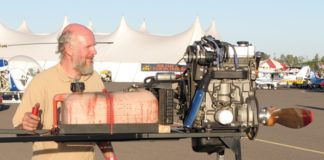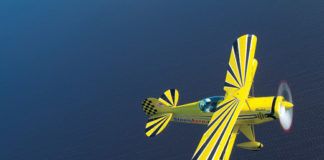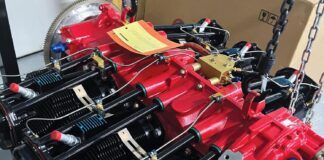Widgets, gadgets, toys. These are terms to describe those fun, but not strictly necessary, items you may have in your cockpit. Pilots are becoming increasingly reliant on gadgets, which are making life easier as well as more fun. I thought we’d take this opportunity to look at a few and discuss their utility in the cockpit. I will concede up front that none of the devices I’m going to talk about are essential and, yes, you can fly just fine without them. However, some pilots are either intimidated by the new technology or are simply unaware of its capabilities. Consider the ubiquitous autopilot. We don’t really need it, but it adds both safety and convenience, and is now almost de facto standard equipment in a large majority of modern Experimental aircraft.
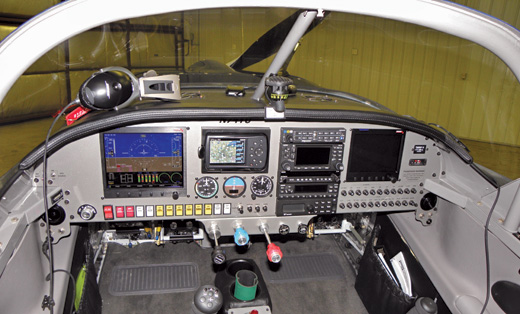
A cockpit with a panel-mounted portable GPS unit.
The Smart Phone
Let’s start with the obvious device, a smart phone. I initially resisted the urge to carry around a little screen and instead preferred my reliable old flip phone. When it finally died, I got a smart phone and thanks to some of my more technically astute friends (geeks) learned of several aviation-specific apps that I could download. For the newbies out there, an “app” is an application you download onto your phone which allows you to run a program that provides some sort of utility or entertainment. I chose to download one of the more popular aviation apps, ForeFlight. It does cost up front, but I figured I could forgo a few months of pizza and extra beer to pay for it. As it turns out, it’s more than worth the money. This little app let me throw away the bulky printed binders of flight guides, airport directories and other paper information I carried around (much of it consistently outdated). While the screen on a smart phone isn’t conducive to actively using the approach plates or sectionals, it really excels in the area of information. Whether you are running ForeFlight, WingX Pro or any other number of great utilities, most of them will provide you with mountains of information in seconds.
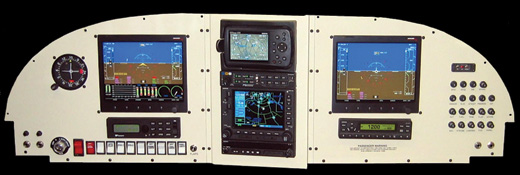
Another example of a panel with a mounted portable GPS.
I also find a great deal of value in these apps for providing weather (on the ground only), TFRs, NOTAMs, airport information, winds aloft and other bits of data that I’d otherwise have to be in front of my computer to retrieve. Again, I wouldn’t try to fly an actual approach with a plate displayed on a screen the size of a business card, but it is handy to look at them anyway. You can zoom into any part of the screen and view pertinent data. It’s also a quick way to find frequencies, runways headings and related information.
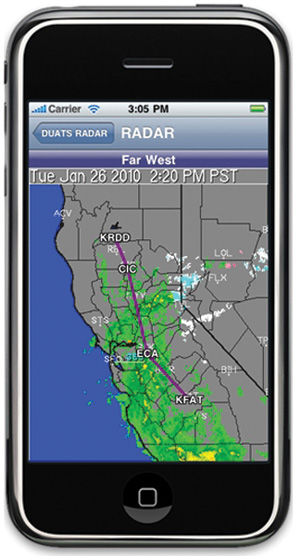
A view of WingX Pro (www.hiltonsoftware.com) on a smart phone.
Along with core aviation data comes another neat perk that I swore I’d never need or use, which is the ability to play music in the cockpit (through your headsets and usually in stereo). Most available modern audio panels and intercoms allow you to plug in your phone or music device. Of course, I’ve heard the argument that music in the cockpit is a distraction, and I concede the point. But if set up correctly, the music will automatically fade and mute any time there is a transmission on your frequency, ensuring you don’t miss communications—or broadcast your songs over the air when transmitting. Even better than plugging it in, some of the new headsets (and the widely acclaimed PS Engineering PMA8000BT audio panel) allow you to use this function wirelessly, via a Bluetooth connection. Most smart phones are Bluetooth enabled, and it’s fun to just hit “play” and sing along.
Perhaps most contentious is making and receiving phone calls in the cockpit. As with music, some headsets and most new audio panels (not most intercoms) will allow you to use your phone with your headset. This phone duplex, or two-way communication, makes it really easy to converse through the headset on a phone call. I won’t comment on airborne phone calls, but I will say that it is handy to make a quick call on the ground before takeoff or after landing without having to shut the engine down or tuck the phone under your headset and hope you can carry on a conversation.
I’ve come to realize that I really like my smart phone, even if it doesn’t make the best calls in the world and I unintentionally dial people when I don’t mean to. The benefits of the aviation apps I have installed outweigh any other issues.
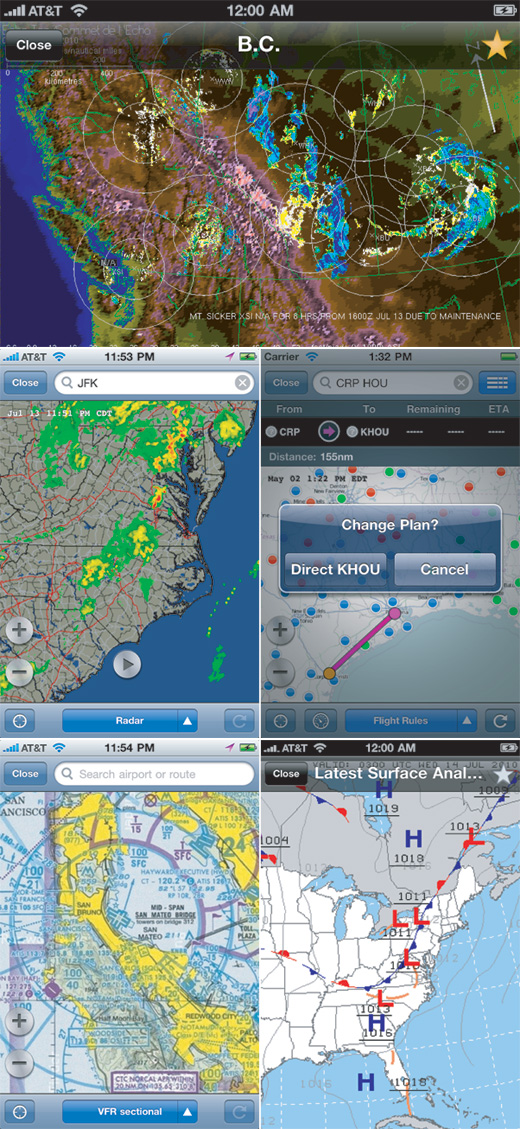
ForeFlight app on an iPhone.
The Tablet
Tablet computers are along the lines of a smart phone, but bigger. My initial thought was, “What could I possibly want with a little computer that actually isn’t a computer but is more like a huge smart phone?” But I finally gave in and purchased one, and immediately changed my mind as soon as I loaded the aforementioned ForeFlight app. Now I had a device where all of the charts, plates and other published materials were more than usable in a clear presentation. No need to purchase a paper sectional, WAC or IFR chart. No more binders full of paper to lug around. No more airport directory bumping around in the baggage compartment.
The tablet version of both ForeFlight and WingX Pro are excellent tools. I personally prefer ForeFlight, but I have friends with both and have heard nothing but positive reviews. It’s helpful to have current and immediate access to any sectional, IFR chart or plate to any part of the U.S. I have them downloaded to my tablet so they are easily accessed anytime I want. Updates are a matter of clicking the update icon a few times a month. The flight-planning functionality (and the ability to quickly and easily file them) is excellent. The internal GPS is only average, so if you intend to use it as a dedicated GPS, purchase an inexpensive add-on/remote wireless GPS receiver that will be solidly reliable.
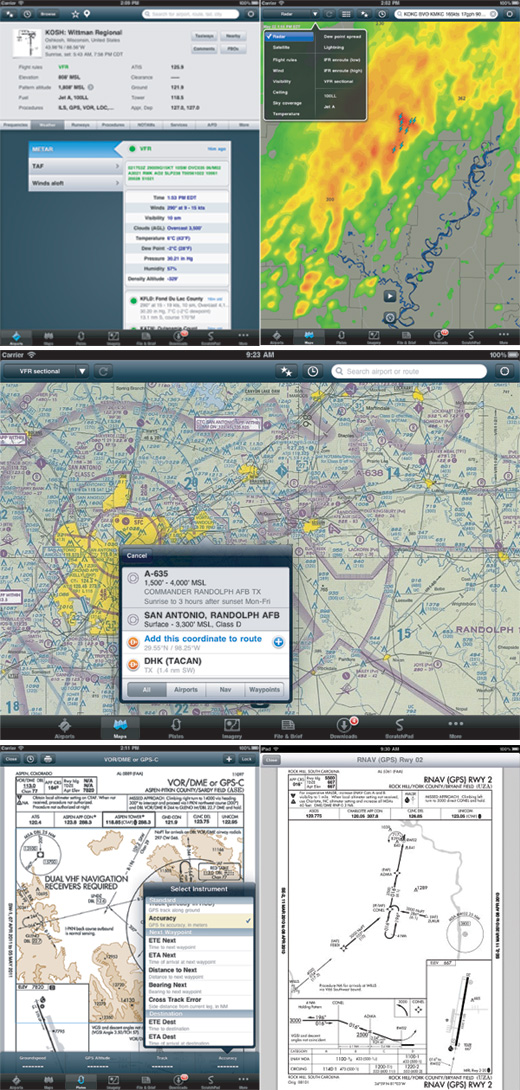
ForeFlight app on an iPad.
Nothing is perfect, however, and tablets do have some drawbacks, starting with sunlight readability. All of these consumer-grade devices have screens that are gorgeous when you view them indoors, but once you get them in the cockpit under the bright sun it’s a different story. In fact, some of them will wash out so much that they appear to be turned off. One solution is to purchase an anti-glare screen protector. Not the cheap $5 types, but one that will cost you $25 or more. (I know, it seems ridiculous for a piece of plastic. But as aviators you should already be used to overpaying for everything you do in an airplane.) I’ve found a number of brands that work well, and settled on a $30 protector from www.powersupportusa.com. Viewing the screen from extreme angles can be somewhat limited, but overall it works well. It’s also rumored that future versions of some of these devices may have better screens because both recreational and professional pilots have adopted them in surprisingly large numbers.
Another issue is battery life. My device will run almost an entire day, but if I play a lot of videos on it or work it hard, battery life can be reduced to four hours or less. For example, if I play my music through the headset while displaying a geo-referenced sectional, run time is quite reduced. While it’s easy to plug into a 12-volt DC power adapter, it means bringing along another cord, so I just encourage you to ensure your device is fully charged before you head out on a long trip.
Some of these devices are also heat-sensitive. If you leave them on the seat under a canopy and it gets much above 120° F, they may need a few minutes to cool down before they will work. A few folks who have had issues with this in the cockpit, say it can often be handled by how and where you mount or set the tablet. These are not avionics grade devices, but they do perform pretty well in most normal temperature ranges. Also, if you are like me and sometimes tend to drop or damage things in your cockpit, purchasing a decent case for your tablet is a good investment.
These devices can cost hundreds of dollars, but when you take everything into consideration, they end up being worthwhile. I now use my tablet to check email, watch videos, read books, play a few games, take pictures and videos, and more fun stuff. That is my justification story, and I’m sticking to it!
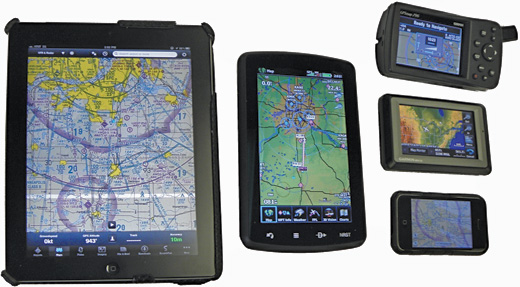
Screen sizes and resolutions vary, as do the aviation-related applications. In this group, an iPad, Garmin units and an iPhone.
The Portable GPS
While we’re on the subject of small tablet devices, I’d be remiss if I didn’t discuss portable GPSes. The line between a dedicated portable GPS and a multifunction device has become quite gray. Garmin has been the clear leader in portable GPSes, and the company is actively working to keep up with the ever-changing technology. The new aera 795/796 series touchscreens are nice pieces of work. (See a full review of the Garmin aera 796 in the February 2012 issue of KITPLANES®, Page 17.) This is not to say the past offerings were substandard, but this new box really is in another league. It is one of the best portable GPSes I have used.
One area in which the portable GPSes excel is weather. At the moment the only easy way to get anything close to real-time weather is with the XM satellite service. While I often hear people complain about the monthly cost, you only need to get stuck somewhere behind some weather once (or worse yet, get stuck in some weather), and the price doesn’t seem so bad. Look at it this way: If you have a $40,000 to $200,000 airplane, a few extra hundred dollars per year is not a bad investment. Even if you do not fly a lot of IFR, you’ll find weather in the cockpit to be valuable. For example, I often use the active winds aloft to find the least amount of headwind (I’m never graced with tailwinds, so I’m accustomed to it by now.)
But Wait, There’s More
At some point we are promised future access to ADS-B (Automatic Dependent Surveillance-Broadcast) weather in our cockpits. At present, coverage is pretty good on the coasts and in many metropolitan areas, but still in development in other parts of the country. But I’m confident we’ll see solutions for portable devices, GPSes as well as computers, that will give us traffic and weather capabilities at a low cost.
Along with weather (and the fact that we mentioned ADS-B), many pilots recognize the benefit of having some sort of traffic or collision avoidance information available. Sure, you can spend $8,000 on a new TCAS-type device, but there are alternatives. The portable traffic detection devices available from Zaon and Monroy are the most popular and give you basic traffic information while being portable and easy to use. I’m also confident that ADS-B functionality will provide both traffic and weather to the devices we’ve discussed.
Some common widgets I used to see as secondary devices in cockpits are now either becoming integrated into the panel-mount avionics or into the new portable devices. Carbon monoxide detectors can be integrated into most panel-mount EFISes, GPSes are being melded with phones and tablets, and independent music players have gone the way of the dinosaur. Look for things to continue on the path of becoming simpler, yet more complex, as newer devices and gadgets are invented and integrated. There’s no need to fear them. No matter your age or experience level with technology, you’ll find the new devices so well designed that you’ll actually enjoy using them. The downside may be that you’ll no longer have expired charts to wrap gifts in.










